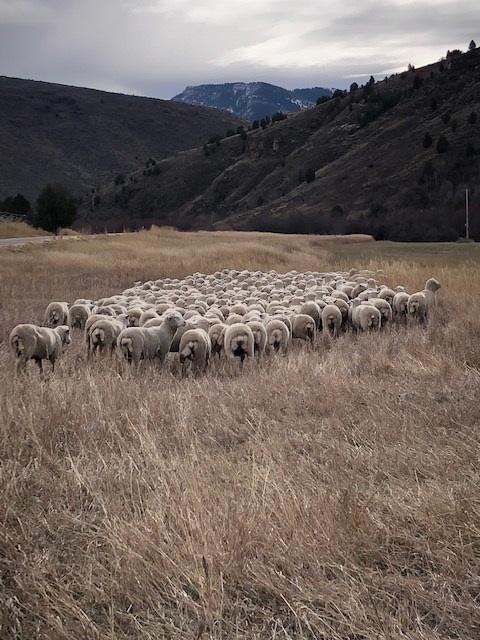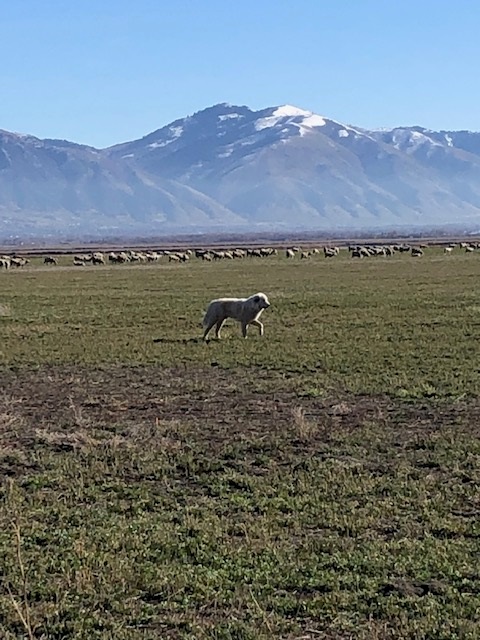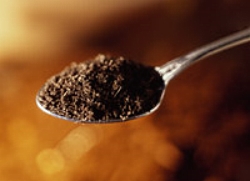
Courtesy & Copyright Mary Heers, Photographer
 Pyrenean Mountain Sheep Dog
Pyrenean Mountain Sheep Dog
Near Mendon
Courtesy & Copyright Mary Heers, PhotographerLast week, while driving along the western edge of Cache Valley just north of Mendon, I saw a huge herd of sheep complete with a sheepherder’s hut. I slammed on the breaks and jumped out with my camera to catch a few pictures of this rippling river of white. As I approached, a big beautiful white stepped out of the flock. This sheepdog was on the job, protecting the flock from any intruders. As we took a long look at each other, I remembered the story of a similar dog who made quite a splash in the local news 20 years ago.
In this story, a Bear Lake resident, Jimmy Stone, spotted a white Pyrenean in Logan Canyon, and got to worrying if it was lost. He started taking daily trips up the canyon to fill a bowl with dog food and tasty treats. The dog came down to eat the food, but would not leave the area. Jimmy hiked up a nearby ridge, and with the help of his binoculars, discovered the dog’s secret: This loyal guardian dog was sticking with 3 lost sheep. Hoping to lure all 4 off the mountain, Jimmy dropped off a bale of hay. The sheep did not come own, so the dog carried the hay up the hillside – bit by bit. Jimmy dropped off branches of crispy apples. The dog carried them up. The sheep were not coming down, and the dog was not leaving without them. Winter snow arrived. Jimmy bought out all the corn dogs at a local convenience store and threw them like tiny footballs up to the dog. More snowstorms arrived. It was time to ask for help. Search and Rescue showed up immediately with snowmobiles and sleds. This story has a happy ending as the search and rescue team managed to get the dog and the sheep safely off the mountain.
Meanwhile, back on the side of the road north of Mendon, I found out this huge herd of sheep had spent the summer in the mountains above Hardware Ranch. They had been brought here by trucks and were now gleaning a local farmer’s alfalfa fields. Soon the trucks would return to take them to Nevada to spend the winter.
How different this huge herd was from the early pioneer days in Mendon when most people only owned a family milk cow and a few smaller animals. It was the job of the local “herd boy” to gather the milk cows and take them up the mountain to graze during the day. Apparently taking the cows home was the easy part of this job. Each cow knew exactly where she lived and would peel off the group at their own garden gate.
Unfortunately, over time, as the livestock populations increased, the Mendon mountain got severely overgrazed. Each rainstorm would send rocks and mud crashing down the steep slopes. Trying to persuade the town council to get the livestock off the mountain and let the vegetation recover, John O Hughes made a bold move. During a council meeting, he took his glass of water and dumped half of it over the head of a bald man. Everyone watched in stunned silence as the water rolled right off the bald head and soaked the man’s shirt. Hughes then dumped the rest of the water onto a man with a bushy head of hair. This man’s shirt stayed dry. That settled the debate.
To this day, the Mendon mountain is green and wooded. It’s nothing short of a hiker’s paradise.
This is Mary Heers and I’m Wild About Utah
Credits:
Photos: Courtesy & Copyright Mary Heers.
Featured Audio: Courtesy & © Kevin Colver, https://wildstore.wildsanctuary.com/collections/special-collections, Courtesy & Copyright © Friend Weller, Utah Public Radio upr.org and Courtesy & Copyright © Anderson, Howe, Wakeman
Text: Mary Heers, https://cca.usu.edu/files/awards/art-and-mary-heers-citation.pdf
Additional Reading: Lyle Bingham, https://bridgerlandaudubon.org/
Additional Reading
Wild About Utah, Mary Heers’ Postings
Great Pyrenees, Dog Breed Profile, Hill’s Pet Nutrition, https://www.hillspet.com/dog-care/dog-breeds/great-pyrenees
Stone, Jim, Stone, Karen, The Legend of BIG BOY Safe or Stranded: An Account of a Real Life Living Legend, Balboa Press, January 7, 2021, https://www.amazon.com/Legend-BIG-BOY-Safe-Stranded/dp/1982260386
Kent, Steve, Dog who refused to abandon sheep in Logan remembered in book, The Associated Press, January 23, 2021, https://apnews.com/article/sheep-canyons-utah-dogs-logan-5a2db87b1fd300b1b39d0de3885ea5eb
“Six hikes are detailed in the Wellsville Mountains above and west of Mendon”
Wallace, David, Cache Hikers 2023, Bridgerland Audubon Society, 2023, https://bridgerlandaudubon.org/product/cache-trails/



